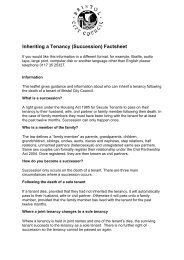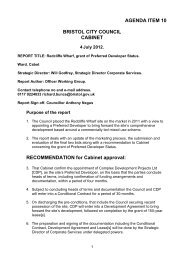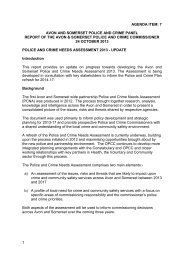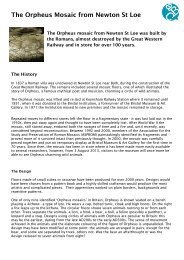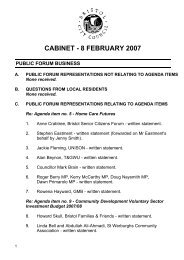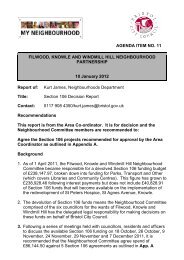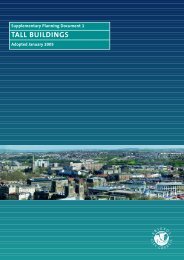public participation - Bristol City Council
public participation - Bristol City Council
public participation - Bristol City Council
Create successful ePaper yourself
Turn your PDF publications into a flip-book with our unique Google optimized e-Paper software.
AGENDA ITEM NO: 5<br />
DEVELOPMENT CONTROL (CENTRAL)<br />
COMMITTEE<br />
7 MARCH 2007<br />
PUBLIC FORUM STATEMENTS<br />
AGENDA<br />
ITEM<br />
APPLICATION(S) NAME STATEMENT<br />
NO<br />
6 (1) 06/03202/F and<br />
06/03211/LC - Clifton<br />
College Rifle Range &<br />
Squash Courts Canynge<br />
Road <strong>Bristol</strong><br />
Demolition of all existing<br />
buildings and<br />
redevelopment with two<br />
semi-detached houses<br />
and garages, including<br />
highway works,<br />
landscaping and boundary<br />
treatment.<br />
Richard Bland 1<br />
“ “ Stephen Wickham 2<br />
“ “ Michael Woodman-<br />
Smith on behalf of<br />
CHIS<br />
3<br />
“ “ Stephen<br />
Macfarlane on<br />
behalf of <strong>Bristol</strong><br />
Civic Society<br />
“ “ Edward Ware<br />
Homes Ltd (see<br />
6 (2) 06/04643/F - <strong>Bristol</strong><br />
Industrial Museum Princes<br />
Wharf <strong>Bristol</strong> BS1 4RN<br />
Retention of M shed<br />
request attached)<br />
<strong>Council</strong>lor Mark<br />
Wright<br />
4<br />
5<br />
6
AGENDA<br />
ITEM<br />
APPLICATION(S) NAME STATEMENT<br />
NO<br />
(existing use as a<br />
museum). Retention of L<br />
shed (existing use as<br />
museum service store -<br />
Level 1) and event space<br />
(Ground floor). External<br />
refurbishment of L and M<br />
sheds. Preservation of<br />
North facade and sliding<br />
doors, with formation of<br />
new entrance. Infill of set<br />
back to South facade.<br />
Addition of single storey<br />
roof extension. Application<br />
for A3 use for ground floor<br />
cafe. Application for A3<br />
use for roof level function<br />
space.<br />
“ “ Sue Thurlow<br />
7<br />
(PWAG)<br />
“ “ Stephen Wickham 8<br />
“ “ Stephen Layland 9<br />
6 (3) 06/04694/F - 157-159 St<br />
Michaels Hill <strong>Bristol</strong> BS2<br />
8DB<br />
Change of use from<br />
existing shop (Class A1) to<br />
mixed use as cafe<br />
bar/restaurant (Classes<br />
A3 and A4) and the<br />
erection of a single storey<br />
kitchen extension to the<br />
rear.<br />
Mrs M. Clifford 10<br />
“ “ Peter Macey 11<br />
“ “ Jonathan Filby 12<br />
“ “ Mr. I. A. Page 13<br />
“ “ Mike Garton 14
AGENDA<br />
ITEM<br />
APPLICATION(S) NAME STATEMENT<br />
NO<br />
6 (4) 06/04097/X - Land At Paul Talbot on<br />
15<br />
Canons Marsh Anchor<br />
Road <strong>Bristol</strong> Harbourside<br />
<strong>Bristol</strong><br />
Section 73 application<br />
relating to the<br />
development of buildings<br />
3A, 3B, 5, 6, and 7 for<br />
residential (C3), retail (A1),<br />
office (B1) and food and<br />
drink (A3, A4, A5) in<br />
compliance with variation<br />
of condition nos. 3, 4, 13<br />
and 50 of planning<br />
approval ref. 04/03230/X<br />
by virtue of amendments<br />
to the permitted land uses,<br />
changes to the approved<br />
total, residential, retail and<br />
office floorspace and<br />
changes to the permitted<br />
number of car parking<br />
spaces.<br />
05/04131/F - Land At<br />
Canons Marsh Anchor<br />
Road <strong>Bristol</strong> Harbourside<br />
<strong>Bristol</strong><br />
Proposed 5 storey<br />
residential building for 48<br />
flats (Class C3) - building<br />
3B.<br />
behalf of Crest<br />
“ “ Edward Cullinan<br />
Architects<br />
16
Sir<br />
My name is Richard Bland and I live with a hundred metres of this site. I have been<br />
opposing this proposal since July 2002 primarily on the grounds that it is contrary both to<br />
government guidelines as expressed in PPG 17 and council policy as expressed in the<br />
Local Plan policy L7b. This states that development will not be permitted if it leads to the<br />
loss of existing indoor sports facilities. If there is a proposal to demolish such facilities<br />
there must be a certainty that they will be replaced by facilities that are as good and as<br />
accessible. There are two facilities at issue, the shooting range and the three squash<br />
courts. Clifton College has twice made different unilateral undertakings under section<br />
106, but the last one, 8 Feb 2005 is now void, and no such undertaking accompanies the<br />
present application. Hence the <strong>Council</strong> has no certainty that Clifton College intends to<br />
replace either facility, and must reject the application on those grounds.<br />
Furthermore it is clear that Clifton College could not make an undertaking that gave<br />
certainty that they would replace the Squash Courts because they have not sought<br />
planning permission for such a structure on their existing campus, and one anywhere else<br />
would not be as accessible. Unless and until they have planning permission for a<br />
replacement squash courts they cannot undertake to replace the present ones, which thus<br />
cannot be demolished.<br />
What Clifton College ought to have done, and what <strong>Bristol</strong> <strong>Council</strong> ought to have<br />
ensured, was to have planned the redevelopment and improvement of both squash courts<br />
and rifle range together with the development of the existing site, so that there was never<br />
any loss of facilities, and that the existing site was truly surplus to needs, and thus<br />
legitimately able to be developed for housing.<br />
There are many other reasons for objecting to this proposal, including loss of protected<br />
open space under policy NE1, the danger to pupils posed by a structure erected five<br />
metres from a rugby pitch, and the proposed insertion into the heart of the conservation<br />
area of a building of incongruous materials and design. Your committee has twice before<br />
accepted these arguments, as have two successive inspectors.<br />
Ensuring the existence of a wide variety of sports facilities for <strong>Bristol</strong> children and adults<br />
matters, and I trust that you will ensure that they are maintained.<br />
R.L.Bland 11 Percival RD BS8 3LN 0117 973 4828
Clifton College Rifle Range 06/03202/F, 06/03211/LC<br />
DCC 7 th March 2007. Attn Mr Steve Gregory<br />
I have sat through four days of the last appeal on this property in part as a speaker on<br />
sport (inc policy L7B) and lines of sight; and in part to observe the machinery of such<br />
an appeal; and having become a participant cross examined some of the witnesses.<br />
I have always felt this building more than appropriate to the New Build zones of<br />
Portishead where it would make a most prestigious impact within a sea of early 21 st<br />
century developments. I have equally always felt it completely inappropriate to the<br />
Northern Half of Canynge Road in the Clifton Conservation area. Context is a vital<br />
consideration. The original proposal made for poor townscape, a silly little dolls<br />
house among solid stone villas as a local resident put it to the inspector. Clearly<br />
neither he nor I considered the proposal conserved or enhanced the conservation area.<br />
During the appeal I have listened to learned architectural arguments about the need<br />
for this style of building to be symmetrical to fit a Regency period aesthetic. I am<br />
therefore amazed to see what has been done to the structure in an attempt to shoe horn<br />
it around the inspector’s final grounds for refusal. This includes making it lopsided to<br />
get around issues with the neighbouring property, while introducing new overlooking<br />
windows. This appears to me akin to cutting off a child’s right arm in the hope of<br />
bettering the chance of receiving a scholarship for left handed children. Crippling the<br />
building to order is no grounds for approving the proposal, and it still does not<br />
conserve or enhance the conservation area.<br />
Therefore I support the officers’ recommendation that the proposal be refused.<br />
I would urge you to reject the scheme.<br />
Stephen Wickham<br />
201 Coronation Rd BS3
Canynge Road Application Nos 06/03202/F and 06/03211/LC<br />
Statement by Michael Woodman-Smith<br />
Planning Group<br />
Clifton & Hotwells Improvement Society<br />
As you will know, this is the third planning application to be submitted on behalf of Clifton College for<br />
the redevelopment of a part of the School’s playing fields and sports facilities on Canynge Road.<br />
This Committee has twice refused planning permission for this redevelopment; CHIS has assisted<br />
CRCG (the local campaign group) at two Planning Inquiries. This application is for essentially the<br />
same scheme as previously submitted, with only a few very minor amendments. None of these<br />
address any of the fundamental principles for development established by the two Inquiries, nor any<br />
of the fundamental concerns regarding the failure of the scheme to harmonise and blend with the<br />
sensitive surroundings, both architectural and landscape, in this part of the Clifton Conservation<br />
Area. Our objections are based closely upon these two Planning Appeal decisions: please refer to<br />
our document ‘Analysis of Planning Appeal Issues’ which we understand was included in the dossier<br />
provided to Members by the CRCG.<br />
We would like to propose amended grounds for refusal in the event that the Committee agrees the<br />
Officers’ recommendation to refuse planning consent to the above application.<br />
You will appreciate that it is important to give the <strong>Council</strong>’s team, as well as the team representing<br />
the local residents, the best possible chance of success at the forthcoming Planning Appeal.<br />
1. Loss of Sports facilities<br />
The proposal would result in the permanent loss of the well-used, purpose-built, squash<br />
courts building due to Clifton College’s Unilateral Undertaking, which offers an alternative<br />
comparable squash facility, being legally unenforceable due to its lack of clarity, certainty<br />
and relevance to the current applications. Consequently the proposal would be contrary<br />
Policy L7B of the <strong>Bristol</strong> Local Plan First Deposit Proposed Alterations 2003 which requires<br />
that ‘an alternative up to date facility has been identified in consultation with the local<br />
community’, that this ‘alternative provision is made of at least an equivalent standard in an<br />
accessible location’, and that this facility is provided without any time delay so that it can<br />
serve existing users. The proposal would also be contrary to the Inspector’s conclusion in<br />
the appeal APP/Z0016/A/05/1183395 that the proposal would accord with Policy L7B and<br />
that there would be “permanent replacement facilities”.<br />
2. Conservation Area<br />
It is considered that the design proposal would have a damaging effect upon the character of<br />
the Conservation Area, both in terms of the landscape and the built form. It would neither<br />
enhance nor preserve the Conservation Area. The design proposal fails to comply with the<br />
principles established by the first Planning Inquiry for this site, nor with the specific<br />
objections of the second Planning Inquiry.<br />
40 Canynge Square Clifton <strong>Bristol</strong> BS8 3LB telephone: 0117 3778825<br />
email: mike.woodman-smith@blueyonder.co.uk
3. Consequences for the Amenity of the Neighbouring Residents<br />
The building would be unduly assertive and dominant resulting in unacceptable overlooking<br />
and infringement of the privacy of the adjoining residents.<br />
4. Non Compliance with Policy and Guidance<br />
The design proposal is considered to be in contravention of Local Plan Policies Chapter 4<br />
(The Built Environment) B1, B2, B8, B13, B16<br />
The design proposal is considered to be in contravention of Local Plan Policy Chapter 10<br />
( Leisure) L 7(b)<br />
The design proposal fails to comply with the principles of PPG15 and PPS1.<br />
The design proposal fails to comply with the findings of two previous Appeal Decisions<br />
(APP/Z0116/A/03/1114350 and APP/Z0116/E/03/1114348 14 November 2003 and<br />
APP/Z0116/E/05/1186528 and APP/Z0116/E/O5/I183395 11 April 2006 ) as summarised in<br />
the CHIS document ‘Analysis of Planning Appeal Issues’<br />
Michael Woodman-Smith
From: Stephen Macfarlane <br />
To:<br />
<br />
Date: 06 March 2007 11:29:05<br />
Subject: Canynge Road<br />
06 March 2007<br />
comment to the Development Control Central Area Planning Committee<br />
for the Meeting to be held on 07 March 2007, from Stephen Macfarlane.<br />
Ref : Item 1<br />
Application Numbers : 06/03202/F and 06/03211/LC<br />
Proposed Development of Clifton College Rifle Range and Squash Courts<br />
at Canynge Road, Clifton.<br />
These applications relate to new development within an important<br />
Conservation Area of the <strong>City</strong> of <strong>Bristol</strong>.<br />
I have approached these applications with the benefit of knowledge<br />
gained from attendance at the Public Inquiry held between 7 and 10<br />
February last year to consider the same site and the same proposal<br />
now resubmitted by the applicant.<br />
The Inquiry was the result of an appeal against refusal of planning<br />
consent and the proposal was subjected to very detailed witnesses and<br />
many members of the local community.<br />
My own interest came about from being a former local resident and as<br />
a member of <strong>Bristol</strong> Civic Society for whom I gave evidence to the<br />
Inquiry that supported the decision by the Central Area Planning<br />
Committee. It is my considered opinion as an architect who has long<br />
experience of working on conservation issues in <strong>Bristol</strong> that the<br />
applications now submitted do not resolve the major objections<br />
identified in the Public Inquiry nor do they contribute to the<br />
conservation or enhancement that is necessary to maintain the<br />
character of this remarkable Conservation Area.<br />
I wish to endorse the advice given by your Officers that these<br />
applications should be refused by the Committee.<br />
On behalf of <strong>Bristol</strong> Civic Society I confirm that the Society<br />
supports this view and also the grounds for refusal that have been<br />
suggested by Clifton & Hotwells Improvement Society.<br />
Yours sincerely,<br />
Stephen Macfarlane<br />
CC:<br />
"WOODMAN-SMITH, Michael & Gillian Woodman-Smith"<br />
,
From: "Heidi Davis" <br />
To:<br />
"Simon Trafford" ,<br />
<br />
Date: 06 March 2007 11:37:48<br />
Subject: RE: Development Control (Central) Committee: 7 March 2007<br />
Thankyou for this which was received at 11:20am which I have also<br />
forwarded to Clifton College. We had decided not to make a presentation<br />
to the Committee tomorrow on the report made available last week but now<br />
wish to reserve the right to do so following receipt of the attached<br />
addendum. I understand any statement should be with you by 12noon today<br />
ie in 25 minutes time. Clearly this is not possible and in the<br />
circumstances I would be grateful if you could please advise on an<br />
alternative timescale to allow our statement to be submitted and given a<br />
chance to be read out tomorrow evening at the committee meeting.<br />
I look forward to hearing from you by return.<br />
Heidi Davis<br />
Planning Director<br />
T: 0117 9071200<br />
F: 0117 9071201<br />
M: 0781 8095616<br />
E: heidi@edwardware.co.uk<br />
Edward Ware Homes Ltd<br />
36 Whiteladies Road<br />
Clifton<br />
<strong>Bristol</strong><br />
BS8 2LG<br />
-----Original Message-----<br />
From: Simon Trafford [mailto:BRPLSYT@bristol-city.gov.uk]<br />
Sent: 06 March 2007 11:13<br />
To: Heidi Davis<br />
Subject: Fwd: Development Control (Central) Committee: 7 March 2007<br />
Heidi,<br />
Please find an addendum report for agenda item no.1: 06/03202/F &<br />
06/03211/LC- Clifton College Rifle Range and Squash Courts, Canynge<br />
Road. The report completes officers views with regards to the loss of<br />
Sports Facilities.<br />
Happy to discuss any issues arising.<br />
regards,<br />
Simon<br />
Simon Trafford<br />
Area Co-ordinator<br />
Central Area Planning Team
<strong>Bristol</strong> <strong>City</strong> <strong>Council</strong><br />
______________________________________________________________________<br />
Please note the new simpler name for our website:<br />
http://www.bristol.gov.uk<br />
Our email addresses have also changed - visit<br />
http://www.bristol.gov.uk/bigchange for further details.<br />
Sign-up for our email bulletin giving news, have-your-say and event<br />
information at: http://www.bristol.gov.uk/newsdirect<br />
CC:<br />
"Mike Innes"
From: Mark Wright<br />
To:<br />
jo.edwards@bristol.gov.uk<br />
Date: 28 February 2007 15:55:57<br />
Subject: Industrial Museum<br />
Dear Jo,<br />
Please pass on the following statement to the DC committee on Mar 7th.<br />
----------<br />
The original Museum of <strong>Bristol</strong> plans were bold, but were out of tune with the<br />
vision that <strong>Bristol</strong> residents had for the building. It is to Cllr Anne White's<br />
credit that she intervened to ensure that <strong>Bristol</strong> could get a MoB that people<br />
wanted.<br />
I am very pleased to see this new set of plans. This building will be one of<br />
very few original functional buildings left on the Harbourside which makes it<br />
all the more important that we retain it as it is. The scene of the industrial<br />
museum will continue to sit on the south side of the Harbour, clearly<br />
reminding residents and tourists alike of the history of the Harbour and the<br />
buildings on it.<br />
Therefore, please support the plans before you today.<br />
---------------------<br />
Yours,<br />
Mark<br />
--<br />
Dr Mark Wright<br />
Liberal Democrat <strong>Council</strong>lor for Cabot
From: "Thurlow, Sue" <br />
To:<br />
<br />
Date: 04 March 2007 22:48:48<br />
Subject: Development Control (Central) Committe - Application Ref<br />
06/04643 /F - Princes Wharf - Attn Steve Gregory<br />
I'm writing to give you notice that I would like to make a statement on<br />
behalf of Princes Wharf Action Group to the Development Control (Central)<br />
Committee on Weds 7th March regarding application ref 06/04643/F. The<br />
statement, already submitted as a comment to the planning department, is as<br />
follows :<br />
The <strong>City</strong> <strong>Council</strong>'s plans for the refurbishment of the Princes Wharf transit<br />
sheds to house the Museum of <strong>Bristol</strong> take full account of the results of<br />
extensive <strong>public</strong> consultation over the past 2 years. The site is part of<br />
the best remaining 1950s general cargo wharf in the country, and the<br />
consultation has led to a conservation-based approach which as far as<br />
possible preserves both the physical aspects of this, such as the massive<br />
sliding doors making up the docks-facing façade, and the much-loved gritty<br />
feel of a historic working dockside. In order to create an effective museum<br />
building some necessary interventions have been included, such as the 2-bay<br />
glass entrance in the centre of the building, and these are sensitive to the<br />
nature of the building and the site. The plans include visual links, through<br />
creative use of the sliding doors, between the dockside and the stories and<br />
objects inside the museum, and will provide opportunities for the museum to<br />
be closely integrated with its surroundings. The plans also include the<br />
supporting infrastructure necessary to ensure the continued operation of the<br />
Museum Services large and very popular working exhibits - the cranes, the<br />
boats & the railway.<br />
Princes Wharf Action Group was formed almost 2 years ago with the objective<br />
of supporting the Museum of <strong>Bristol</strong> project by pressing for a conservation<br />
approach to the building and for effective <strong>public</strong> consultation. We are now<br />
happy to give our full support to the planning application currently under<br />
consideration.<br />
Regards,<br />
Sue Thurlow<br />
9018305<br />
This e-mail is only for the above addressees. It may contain confidential or<br />
privileged information.<br />
CC:<br />
Museum of <strong>Bristol</strong> 06/04643/F<br />
DCC 7 th March 2007. Attn Mr Steve Gregory<br />
This proposal has turned out so much better than originally feared when it<br />
finally came in late 2006, that I think most campaigners against the (dreadful)<br />
first and second proposals made <strong>public</strong> in 2005 have now relaxed and<br />
decided not to comment. The watershed event was the heated <strong>public</strong> meeting<br />
at the <strong>City</strong> Museum and Art Gallery in September 2005 and a few weeks later<br />
the politicians decided to intervene to put the project on a new financial base,<br />
and conservation based approach, in response to the prevalent <strong>public</strong> view.<br />
As an original PWAG member I would endorse Sue Thurlow’s recent letter of<br />
support for the application.<br />
I can quite see that <strong>Bristol</strong> might benefit from a wild 21 st century building to<br />
compare or contrast with the Opera House at Cardiff Bay somewhere else in<br />
the central area, but linking this idea with <strong>Bristol</strong>’s hugely successful old<br />
industrial museum structure and surrounding period industrial infrastructure<br />
was always a disastrous concept. This is clearly a very sensitive sector for<br />
designers to engage with and in this case it appears to have turned out “all<br />
right on the night” despite a fraught development process.<br />
Therefore I support the officer’s recommendation that the proposal be<br />
approved.<br />
I would urge you to accept the scheme.<br />
I look forward to visiting the completed MOB at the earliest opportunity.<br />
Stephen Wickham<br />
201 Coronation Rd BS3<br />
<strong>Bristol</strong> BS3 1RQ
From: Stephen LAYLAND <br />
To: <br />
Date: 06 March 2007 09:59:22<br />
Subject: WRITTEN STATEMENT from Stephen Layland for 7th March DC{Central}<br />
Committee Agenda Item 4<br />
From:<br />
Stephen Layland<br />
73 Hampton Park<br />
Redland<br />
<strong>Bristol</strong><br />
BS6 6LQ<br />
Att'n Steve Gregory<br />
For:7th March 2007 Meeting of the Development Control [Central] Committee<br />
Subject: Stephen Layland's Written Statement of objection to the application under<br />
Agenda Item 2 - 06/04643/F<br />
<strong>Bristol</strong> Industrial Museum Princes Wharf <strong>Bristol</strong> BS1 4RN<br />
Retention of M shed (existing use as a museum). Retention of L shed (existing use as<br />
museum service store - Level 1) and event space (Ground floor). External<br />
refurbishment of L and M sheds. Preservation of North facade and sliding doors, with<br />
formation of new entrance. Infill of set back to South facade. Addition of single storey<br />
roof extension. Application for A3 use for ground floor cafe. Application for A3 use for<br />
roof level function space.<br />
Please allow me to voice an oral introduction paraphrasing the substance of the<br />
following written ATTACHED statement of objection to:<br />
the truly iconic inapproriateness of both the principle and architectural form of the<br />
plan to incorporate the proposed "Museum of <strong>Bristol</strong>" largely within the telling<br />
"pathology" of some otherwise nondescript conversion of the "grimly utilitarian" post-war<br />
sheds that, until recently, housed <strong>Bristol</strong>'s Industrial Museum.<br />
Attached WRITTEN STATEMENT OF OBJECTION<br />
Stephen Layland.<br />
---------------------------------<br />
New Yahoo! Mail is the ultimate force in competitive emailing. Find out more at the<br />
Yahoo! Mail Championships. Plus: play games and win prizes.
From:<br />
Stephen Layland<br />
73 Hampton Park<br />
Redland<br />
<strong>Bristol</strong><br />
BS6 6LQ<br />
Att’n Steve Gregory:<br />
For:<br />
7th March 2007 [6.pm] Meeting of the Development Control [Central] Committee.<br />
Subject:<br />
Written Statement of objection to the application under Agenda Item 2 - 06/04643/F<br />
Please allow me to voice an oral introduction paraphrasing the substance of the following<br />
written statement of objection to:<br />
both the principle and architectural form of the tell-tale corporate/civic pathology that<br />
would incorporate the proposed "Museum of <strong>Bristol</strong>" largely within some otherwise<br />
nondescript conversion of the "grimly utilitarian" post-war sheds that, until recently,<br />
housed <strong>Bristol</strong>'s Industrial Museum.<br />
As would be the case of the Museum of any city’s History, the architecture housing the<br />
inherently iconic subject of the "Museum of <strong>Bristol</strong>" would itself be inherently iconic and, as<br />
such, will be inevitably come to be understood as having enormous symbolic and historic<br />
significance as an educational object and architectural lesson in itself - albeit a lesson on the<br />
“folly” by which the corporate and civic interests seem content to see a city to become ever<br />
more deeply attached within the prison of the Boiled Frog Syndrome.<br />
The architectural unit is best thought of as the city. The unit is not some block, or<br />
column, or window; not some chamber or single building, but the whole complex of<br />
structures in organic relation which make up the city, the breeding place of men. Each<br />
least work must be done in loyalty to the whole.<br />
W. R. Lethaby A National Architecture - I<br />
The Builder Oct 4th 1918<br />
The lesson of history by which peoples knowing and needlessly continue with a fateful<br />
policy despite knowing that a better one exists.<br />
Barbara Tuchman The March of Folly<br />
Those that take the inherently iconic history [past and present] of <strong>Bristol</strong> to be unworthy of<br />
being acknowledged by the rise of some more celebratory architecture should necessarily<br />
agree that some more generalised breakthrough or departure is required. The corollary is that<br />
the promise in the launch of that departure should be taken to be occasion marked by the<br />
commissioning of some fitting work of architectural celebration – namely a work in which the<br />
architect undertakes to subordinate their personal ego to the need celebrate the promise in<br />
the past, present and future history of <strong>Bristol</strong>.<br />
The tragedy is that the record of the many development around <strong>Bristol</strong>’s Floating Harbour –<br />
under the licence of The Habourside Brief – have left the people of <strong>Bristol</strong> with nothing more<br />
worthwhile to cling to but the conceit that some protest-group had somehow “saved” the<br />
facade and frame of the otherwise nondescript grimly-utilitarian frame of the post-war sheds.<br />
1
The irony is that the same Habourside Goup that had facilitated the wholly dreadful<br />
developments that are still rising to surround <strong>Bristol</strong>’s Floating Harbour were allowed to<br />
change sides and appear to agree with the protest-group in appearing to support the retention<br />
of the otherwise nondescript grimly-utilitarian frame of the post-war sheds.<br />
While the low line of two-story sheds provides and acceptable lines of any partly enclosed<br />
perspective, the same lines create a quite dreadful anticlimax, when sen crossing the end of<br />
the panorama of St Augustine’s Reach. The attachment of the boxed extension [as if] on the<br />
roof of the post-war sheds manages to achieve the impossible – only making things worse.<br />
The "vision" of the Harbourside Development Brief is, pointedly, to: unlock the vast potential of<br />
the area and make it one of the centres of attention for investment in <strong>Bristol</strong>.<br />
Now that the Members of the Development Control [Central] Committee have endorsed almost<br />
all the remaining development plans for the available sites, the key provided by the Harbourside<br />
Development Brief has since turned full circle and is about to lock <strong>Bristol</strong>’s Floating Harbour<br />
against the precedent of some more enlightened approach to urban development – turning to<br />
lock the <strong>Bristol</strong>’s inherently iconic Floating Harbour against the transformative moves of paradigm<br />
change or departure.<br />
It could hardly be argued that the content Museum of <strong>Bristol</strong> is somehow going to open the<br />
minds of the visitors to the deeper and more useful lesson of <strong>Bristol</strong>. The exhibitions would be far<br />
more likely to work to leave the visitors in ignorance of everything of real relevence in the<br />
patterns of <strong>Bristol</strong>’s history.<br />
It is widely improbable, for example, that the Museum of <strong>Bristol</strong> will allude to the extent to which<br />
the arrival of the SS Windrush should be understood as actually marking the “return of the long<br />
repressed” – acknowledging the return of the perfectly symmetrical consequences of <strong>Bristol</strong>’s<br />
enthusiastic attachment to the business of the Slave Trade.<br />
The architectural form of the proposed Museum of <strong>Bristol</strong> perfectly expresses the extent to<br />
which the urban development in <strong>Bristol</strong> is dominated by the wholly internal considerations, as<br />
if the extension of those internal/sovereign considerations into the <strong>public</strong> realm where some<br />
wholly incidental consideration.<br />
This distinction is enough to explain the feeling of empty sterility, the odd proportions and the<br />
seemingly random scattering of Art after-thoughts within <strong>Bristol</strong>’s <strong>public</strong> realm – negative<br />
qualities most obviously found throughout the redevelopment of “Maggies Island” nee<br />
Canons’ Marsh.<br />
The same distinction also reflected in <strong>Bristol</strong>’s corporate and civic indifference to the infinitely<br />
deep dictates of the visual sensibility and, above all, literally, the de facto lack of vision or<br />
blindness [as if] brought about by a mixture :<br />
of corporate tunnel vision and civic myopia.<br />
The plan to contain the inherently iconic history of <strong>Bristol</strong> within the rectilinear frame amounts<br />
to an acknowledgement that the corporate and civic interests of <strong>Bristol</strong> are widely indifferent<br />
to the actual state of <strong>Bristol</strong> - trapped in a crisis of civic mediocrity, notwithstanding<br />
the excellence of the undertakings of a few individuals in launching wholly atypical<br />
breakthroughs [as if] against the drift of corporate and civic interests.<br />
The tragedy of a city that has long been trapped at the boundary of diminishing returns is its<br />
corporate and civic interests come to be deeply embedded and attached to the sort of<br />
extensions than can be achieved through the use of the manipulative trick – i.e. able to<br />
achieve the profits of quantitative extension that the cost of foreclosing the promise of the<br />
much greater rewards that would flow from qualitative transformation.<br />
2
The extent to which the manipulative tricks have become the first rule of corporate practice on<br />
all sides and every level can be seen at:<br />
• the meta-level of setting the original decisions of the Secretary of State for Culture,<br />
Sport and Leisure in potential opposition to the decision of the Office of the Deputy<br />
Prime Minister on the same subject; and by<br />
• uploading the computer-generated graphics of proposed developments onto the BCC<br />
website not by using the grey-scale but as highly contrasting black-and-white<br />
reproductions that serve to make the images completely unreadable and, as such,<br />
refuting the sham facade of due process.<br />
The Boiled Frog Syndrome refers to the situation in which corporate and civic interests would<br />
rather extend the fateful status quo [to the death] than face the marginal costs and supposed<br />
trauma of having to admit to having long been content to carry-on with a range of misguided<br />
[almost thoughtless] undertakings – undertaking based [at outset] on nothing more thoughtful<br />
and worthy than some un-argued [merely assumed] consensus.<br />
The fact that the architecture of the proposed Museum of <strong>Bristol</strong> will be cloaked in some<br />
seemingly positive rhetorical facade only draws attention to its own pathology – i.e. reflecting<br />
a self-conscious mismatch between the sham facade of appearances and the crisis at the<br />
level of corporate interests that are quite unable to acknowledge the flaws in the history of<br />
<strong>Bristol</strong>’s corporate and civic character.<br />
<strong>Bristol</strong> is about to extend itself to occupy a still wider [larger] area. The tragedy is that until<br />
those fateful flaws can be openly acknowledged <strong>Bristol</strong> will never become great city – will<br />
remain a city that relies on: the mask of hypocrisy, the use of the manipulative trick and<br />
pathology of mere extension.<br />
The same mask of hypocrisy is the only obstacle that prevents the world from acknowledging<br />
that non-transformative model of straightforward extension is the root cause of the world’s<br />
environmental crisis. Even the seemingly principled practice of carbon-neutrality has since<br />
come to be employed as just another mask – the partial truth that masks the extension of the<br />
greater lie.<br />
Appearances to the mind are of four kinds. Things either are what they appear to be;<br />
or they neither are what they appear to be; or they neither are, nor appear to be; or<br />
they are, and do not appear to be; or they [matters] are not, and yet [are made to]<br />
appear to be. Rightly to aim in all these cases in the wise man’s task.<br />
Epictetus Discourses<br />
This life's [five] dim windows of the soul<br />
Distort the heavens from pole to pole,<br />
And make us to believe a lie<br />
When we see with, not through, the eye.<br />
Blake<br />
Just because everything looks different, doesn’t mean that anything has changed.<br />
Anonymous.<br />
The attachment to this family of three pathologies will lead to the need to keep visitors [and<br />
school parties] in ignorance [in a state of only partial awareness] of the wider and deeper<br />
lessons of any exhibition likely to found supported in the Museum of <strong>Bristol</strong>.<br />
The result would more nearly equate to the face of corporate and civic propaganda.<br />
• A half truth is a whole lie<br />
Unknown<br />
3
Under The Historic Environment - A New Vision the Government looks forward to a future in<br />
which Pt1[9]:<br />
• the full potential of the historic environment as a learning recourse is realised;<br />
• the historical environment's importance as an economic asset is skilfully harnessed;<br />
Under Realising educational potential<br />
2.1 '....The historic environment has immense value as an educational resource, both as<br />
a learning experience in its own right and as a tool for other disciplines. Whether at<br />
school, in further and higher education or in later life, the fabric of the past constitutes a<br />
vast reservoir of knowledge and learning opportunities.'....'Nor is the education<br />
significance of the historic environment confined to the teaching of history.' [my<br />
emphasis]<br />
The generic pathologies seen expressed in the architectural iconography of the proposed<br />
Museum of <strong>Bristol</strong> perfectly illustrates the extent to which the flaws in the character of the<br />
corporate and civic culture of <strong>Bristol</strong> betray the same family of flaws that are most implicated<br />
in the problems of the world.<br />
• the simplistic logic that finds most perfect expression in the rectilinear [merely<br />
utilitarian] framework<br />
• the pathology of the equally simplistic straightforward boxed extensions, as<br />
attachments to the frame<br />
• the pathology of the hypocritical facade.<br />
The tragic irony is that the hypocritical facade has been retained to mask the extension of the<br />
rectilinear frame - i.e. bringing together the most sublime [dreadful/awful] alliance of the three<br />
damaging pathologies known to be threatening our world today and in the future?<br />
One of the threats of globalisation is that all identity would come to be submerged within the<br />
same more or less homogeneous stew of globalisation. The tragic irony is that this<br />
characterless outcome would appear to correspond to the urban “stew” or “one-stop-shop” of<br />
<strong>Bristol</strong> architectural landscape.<br />
Yet I think of I had to show a foreigner one English city and one only, to give a<br />
balanced idea of English architecture, I should not take him to Oxford or Cambridge,<br />
which have developed in once special direction, nor to the cathedral cities where<br />
nothing much has happened since Henry VIII quarrelled with the Pope, but to <strong>Bristol</strong>,<br />
which has developed in all directions and where nearly everything [architectural] has<br />
happened.<br />
J Summerston <strong>Bristol</strong> and its Architecture<br />
The Listener 2nd December 1948<br />
George Ferguson has still recently said of <strong>Bristol</strong> that ‘it would be very hard for <strong>Bristol</strong> to lose<br />
its identity since we have enjoyed such a variety of buildings over a long historic period’.<br />
The urban stew of the “one-stop-shop” would clearly represent the inverse of the right<br />
principle recognised by Frank Lloyds Wright:<br />
"The mother art is architecture. Without an architecture of our own we have no soul<br />
of our civilisation"<br />
Frank Lloyd Wright Architect [International Style]<br />
4
The error is in framing that lack of some more particular architectural tradition as it were<br />
something positive. Given that all cities are spiralling down into that non-descript<br />
everywhere-nowhere state, the only truly significant distinction is that corporate <strong>Bristol</strong> the<br />
first city to frame its fateful lack of character as if that were somehow a good thing.<br />
The following extract is from the English Heritage recent meta-level Representation to the EiP<br />
review of the South West Regional Spatial Strategy - i.e. within the General RSS Comments<br />
section.<br />
This does not mean that there is a finite limit that should be placed on development.<br />
‘Capacity’ is a flexible concept. It is dependent upon the quality of development as well<br />
as its quantity. High Quality Design and Master planning. The need for these policy<br />
sectors is essential to integrate the levels of development proposed with the quality of<br />
our existing historic environments. The aim should be to ensure that in creating a new<br />
built environment it is as valued as much by future generations as the development<br />
delivered by our forebears is valued by us.<br />
The tragedy of the Boiled Frog Syndrome is that those inside are unable to face the marginal<br />
costs and trauma of having to acknowledge that almost every decision they have made has<br />
served to consolidate the inertia and momentum towards extension rather than the required<br />
departure.<br />
The decision to endorse the recommendations of the Planning Officer would trap the promise<br />
of <strong>Bristol</strong> past, present and future history with the pathology of the now redundant paradigm –<br />
will only add enormously to the marginal cost and trauma that future Members of <strong>Bristol</strong> <strong>City</strong><br />
<strong>Council</strong> will have to face in attempting to bring about the required departure.<br />
The first principle of sustainable development is not to foreclose decisions that should be left<br />
to future generations to decide.<br />
While the decision to launch the departure of paradigm change will be nominally left open for<br />
future generations to take or decline, the recommendations of the Planning Officers and,<br />
indeed, the earlier support of the Full <strong>Council</strong>, will only consolidate the inertia and momentum<br />
against the need to launch that eventual departure.<br />
When raised to the level of the world as a whole, the willingness to add to the inertia and<br />
momentum against paradigm change seems all too fateful – reflecting a hope against hope of<br />
some near death wish.<br />
Where people once are in the wrong<br />
Each line they add is much to long<br />
Who fastest walks, but walks astray,<br />
Is only furthest from his way.<br />
Prior<br />
I would contrast the willingness of BCC to introduce the onerous duty of separating wastes<br />
and recycling bottles and paper, building cycle lanes and road charging while still remaining<br />
deeply committed to the family of pathologies that are most implicated in the cause of the<br />
world’s socio-environmental crisis. This amounts to the attachment of the Boiled Frog<br />
Syndrome – preferring complicity and death to launching the sort of change that would really<br />
made a difference.<br />
Let the decision on this application be known to have been taken as a measure of the level of<br />
indifference of the Members of the Development Control [Central] Committee and the extent<br />
to which some are fettered by the unwillingness to appear to acknowledge past mistake in<br />
having supported earlier developments surrounding <strong>Bristol</strong>’s Floating Harbour.<br />
Stephen Layland.<br />
5
From: ". ." <br />
To:<br />
<br />
Date: 05 March 2007 15:08:15<br />
Subject: ref 06/04694/f<br />
from Peter S Macey<br />
Ponits I wish to raise at commity meeting 7th March<br />
1 At this moment there are valready 6 cafes of which 2 are already licenced<br />
and 3 Public Houses<br />
all serving food and drink in some form or another all within a few meters<br />
of the propsed applicants.<br />
2 We have at present a very difficult problem with parking which is offten<br />
worse during term time one more venue will make a huge impact.<br />
3 Niose pollution at night can sometimes be a problem but at its present<br />
level in not to bad an increase in venues will again add to this problem. I<br />
am sure you are aware that right opposite the proposed venue is an elderly<br />
persons residence from which i am sure youwill have recieved many<br />
objections<br />
4 I and my neighbours keep in close contact with our local beat manager and<br />
have expressed our concerns to him and we are all of the oppinion that at<br />
the present levels noise drunkeness and anti social behaviour are<br />
managable. Any further increase in the number of licenced outlets will<br />
require<br />
an increase in policing and will have an adverse affect on the quality of<br />
local residents lives.<br />
5 Finnally I find it difficult to understand when the original application<br />
for a restaurant was rejected<br />
how this application has been recommended for approval by the planning<br />
officer.<br />
This area of St Michaels Hill is very much a community and does not attract<br />
lots of people from outside the area and we certainly do not wish to become<br />
another Whiteladies Rd<br />
_________________________________________________________________<br />
Exclusive Ed Byrne daily comedy clips on MSN Video<br />
http://specials.uk.msn.com/edbyrne/
Statement to Development Control (Central) Committee<br />
Re: 06/04694/F 157-159 St Michael’s Hill, <strong>Bristol</strong> BS2 8DB<br />
I am an ex- senior Manager of the London Underground and have worked for over 20<br />
years in the <strong>public</strong> sector. My son Tom is a student at the University of West England<br />
and is a regular visitor to the St Michael’s Hill area where he has many friends. I am<br />
here today to represent the students who signed the petition asking for approval to the<br />
European Style café/restaurant at the above address and wish to make the following<br />
key points:<br />
1. The area surrounding the University of <strong>Bristol</strong> Library is currently<br />
severely under catered and if the <strong>City</strong> wish to host two world class<br />
Universities they must provide something approaching world class<br />
facilities for students to use.<br />
2. I am particularly concerned about the lack of seating available in eatinghouses<br />
in the area. On cold and wet days, the type of take-away facilities<br />
that are currently available are wholly inadequate to meet the needs of<br />
hungry and industrious students.<br />
3. I understand that the proposed premises will be suitable, in both pricing<br />
structure and environment for students and local residents alike to use as a<br />
meeting place and an eatery.<br />
4. I have spoken to a number of the parents of friends and associates of my<br />
son and there is unanimous agreement that an additional facility of the type<br />
proposed is urgently needed in the area.<br />
5. I urge the Development Control Committee to take the opportunity to<br />
bring something of the European Café scene to the St Michael’s Hill area<br />
and to offer their full support to the proposed development.<br />
Jonathan RW Filby<br />
5 March 2007
Statement to <strong>Bristol</strong> <strong>City</strong> <strong>Council</strong> Planning Committee<br />
regarding application 06/04694<br />
Change of use at 157-159 St Michael's Hill, <strong>Bristol</strong> BS2 8DB (from retail A1 to A3 AND<br />
A4 usage AND rear extension)<br />
General<br />
1. This application is for the creation a new late night drinking establishment within<br />
the St Michael’s Hill city-village.<br />
2. The area is currently a finely balanced mix of shops, businesses, bars, cafes<br />
and residential housing.<br />
3. That balance will be irreversibly tipped by permitting this application. St<br />
Michael’s Hill will become a secondary late night entertainment strip, akin to<br />
Whiteladies Road, Cotham Hill and Gloucester Road.<br />
4. This is not what the local residents want, nor is it in keeping with the Local Plan<br />
for the area.<br />
Change of Use<br />
Need<br />
1. The premises are situated in a parade of shops, designated as a Local<br />
Shopping Centre. Were they on the opposite side of the road, this application<br />
would, I suspect, have been recommended for refusal. This is because one<br />
side of the road is deemed to be primary frontage and the other secondary.<br />
2. However, being a secondary frontage does not mean carte blanche to convert<br />
shops into bars, merely a greater latitude to do so. Notably, this particular unit<br />
is the only double fronted shop on either side of the road and is in a prominent<br />
location. As such, its loss would be of commensurate significance, both to the<br />
shopping capacity and to the overall viability of shopping in the area as a<br />
whole.<br />
3. It has already been recognised, by this committee that conversions from A1 to<br />
A3/A4 usage has reached a critical point in the area. For example,<br />
A similar application to convert 152 has been refused because ‘food & drink<br />
use would be likely to have a detrimental effect on the amenities of local<br />
residents’ and because ‘loss of retail floor space would seriously undermine the<br />
retail function of St Michael’s Hill’.<br />
Two applications to convert 151 St Michael’s Hill to A3/A5 usage were only<br />
granted with severe conditions limiting opening hours to 10.00pm, restricting<br />
capacity and forbidding its ‘use as a bar, <strong>public</strong> house or any other drinking<br />
establishment’, because ‘a further pub or bar in this location is not considered<br />
appropriate’. Yet, 151 is in the same terrace as the proposed new bar, with just<br />
two building separating them.<br />
4. This application constitutes an excessive depletion of the retail space in the<br />
area and an inappropriate usage.<br />
1. It is not clear that the site is not viable as a shop. The applicant has sent in<br />
evidence that it was marketed from February 2005 to August 2005. This is itself<br />
a relatively short time frame, particularly when for a good part of that time the<br />
premises were under offer to the applicant. It should also be noted that a To Let<br />
sign was only displayed for a couple of weeks before being ‘Let’ so any<br />
interested party not already in contact with the agents would not have had<br />
chance to offer. Since acquiring the building in August 2005, the applicant has<br />
permitted it to deteriorate with an accumulation of graffiti and rubbish; a
Statement to <strong>Bristol</strong> <strong>City</strong> <strong>Council</strong> Planning Committee<br />
regarding application 06/04694<br />
Change of use at 157-159 St Michael's Hill, <strong>Bristol</strong> BS2 8DB (from retail A1 to A3 AND<br />
A4 usage AND rear extension)<br />
situation that some supporters seem to think should warrant the reward of the<br />
applicant, as it will ‘bring the building back into use’.<br />
2. Permission has recently been granted for a similar sized restaurant facility at<br />
142 St Michael’s Hill by means of extending and refurbishing a disused<br />
restaurant. This will more than suffice in the event that a restaurant is genuinely<br />
needed. Indeed, the planning permission specifically seeks to restrict its<br />
restaurant capacity ‘because of the potential detrimental impact’.<br />
3. The need for further A3/A4 premises is highly dubious since two<br />
café/restaurants have ceased operations in the area, one to convert to a<br />
takeaway business and the other has applied for change of use to a shop. In<br />
addition, one of the largest restaurant sites in <strong>Bristol</strong> remains vacant in the<br />
nearby Queens St/Triangle area and has done so for some four years.<br />
4. The application has a number of letters of support and a petition. Close<br />
scrutiny of these letters shows that they come from as far away as Surbiton,<br />
Surrey , Keynesham and Bishopston. The petition is remarkable for the<br />
absence of BS2 postcodes. Indeed, many signatories are students living in<br />
halls of residence in Clifton village and on Clifton Downs.<br />
5. In contrast, the neighbours at Holly Court, sheltered accommodation<br />
immediately opposite the site, have petitioned against, as have a number of<br />
immediate neighbours. The implication is clearly that local people do not want<br />
or need this facility and that such support as the application has comes from<br />
people who will not be affected since they live far away.<br />
Concentration of Uses<br />
1. Immediately opposite the site is the Highbury Vaults Public House.<br />
2. Immediately adjacent to the site is Bar 155, Public House and Restaurant<br />
3. Within the immediate vicinity are a further four licensed premises and another<br />
already granted planning permission but yet to obtain a liquor licence.<br />
4. Policy Advice Note 17 addresses the need to consider carefully the ‘cumulative<br />
effects … from … concentration of similar uses’. It clearly says that ‘Where<br />
such a situation already exists, or is likely to arise from the introduction of<br />
further food and drink establishments, the council will generally resist new<br />
uses’.<br />
5. Permitting this application would constitute excessive concentration of bars and<br />
<strong>public</strong> houses.<br />
Crime, Disorder and Noise Nuisance<br />
1. This issue is closely allied to over-concentration of late night drinking<br />
establishments.<br />
2. These are matters that are normally overseen by the <strong>Council</strong> Licensing<br />
Department rather than the Planning Department. However, the applicant has<br />
not yet made application for a provisional licence under the new 2003 Licensing<br />
Act. A provisional licence application is the proper and normal forum for the<br />
Police Licensing Department to make their position clear. The risk is that, by<br />
granting this application in absence of proper consideration by licensing, a fait<br />
accompli is established.<br />
3. There is a significant risk that, despite planning conditions, the applicant will<br />
seek to obtain similar licence conditions to those of its immediate neighbour at<br />
155. Here they are permitted late night drinking until 2am.<br />
4. A further consideration must be the up-coming smoking ban. The site has no<br />
outside facility to accommodate smokers. Inevitably this will mean a
Statement to <strong>Bristol</strong> <strong>City</strong> <strong>Council</strong> Planning Committee<br />
regarding application 06/04694<br />
Change of use at 157-159 St Michael's Hill, <strong>Bristol</strong> BS2 8DB (from retail A1 to A3 AND<br />
A4 usage AND rear extension)<br />
Transport<br />
concentration of patrons using the street in which to smoke with the attendant<br />
noise and disorder risk.<br />
1. The application makes no provision for parking or even for cyclists. In fact it<br />
removes space that have historically been used as parking for staff.<br />
2. Although previous similar applications have been relaxed about parking<br />
provision, it is now the case that parking provision has reached critical point in<br />
the area.<br />
3. The cumulative effect of a further 100 people in addition to similar numbers to<br />
be anticipated at 142, which is currently under construction, would significantly<br />
increase congestion in the area.<br />
Planning Conditions<br />
1. The recommendation is to grant permission subject to numerous conditions.<br />
This is, I think, indicative of how perilously close to causing harm to the area<br />
this application is.<br />
2. Notably there is condition 2, which attempts to restrict the area available as a<br />
purely drinking establishment. Such a condition is practically un-policeable.<br />
3. Even were you minded to grant permission for a restaurant (A3) the only<br />
prudent way to prevent the additional strain on the amenity and the risk of<br />
increasing crime, disorder and noise would be to refuse A4 permission.<br />
Conclusion<br />
1. This application is not supported by those people who will have to live with the<br />
implications of another late night drinking establishment<br />
2. Granting the application would irretrievably alter the nature of the area to the<br />
detriment of its use as a local shopping centre and as a residential area.<br />
3. The result would be an over-concentration of bars and <strong>public</strong> houses in the<br />
area with commensurate risk of crime, disorder and noise from patrons.<br />
4. The application should be refused as unsuitable taking into account the Local<br />
Plan and PAN17, the inevitable loss of amenity due to noise from patrons on<br />
the street and the wishes of the local residents.<br />
I A Page<br />
133 St Michael’s Hill<br />
Tuesday, 06 March 2007
From: "Mike Garton" <br />
To:<br />
<br />
Date: 06 March 2007 11:42:51<br />
Subject: Planning Application Ref: 06/046941/F<br />
I wish to register my objection to the above planning application for the<br />
following reasons:<br />
1. There are four licensed premises within 400 metres of the premises which<br />
are the subject of this application and another licensed property is simply<br />
not required.<br />
2. Parking is a major problem at the top of St Michaels Hill and the<br />
attraction of another licensed property will only exacerbate the current<br />
problems.<br />
3. Holly Court is situated directly opposite to the premises. Holly Court<br />
has a large proportion of elderly and infirm residents in "sheltered<br />
accommodation". Additional noise nuisance is inevitable and not acceptable<br />
to these residents.<br />
4. St Michaels Hill is not Whiteladies Road and a proliferation of licensed<br />
premises will change the ethos from "local retail" to the "Golden Mile"<br />
ethos of Whiteladies Road.<br />
5. The extra traffic generated together with vehicles driving around in<br />
search of non-existent parking places will create serious noise and exhaust<br />
pollution.<br />
6. There are many adequate licensed premises on Whiteladies Road just 500<br />
metres away and many of these are under-subscribed and struggling to stay in<br />
business.<br />
Yours faithfully<br />
Michael D Garton<br />
29A Cotham Grove<br />
<strong>Bristol</strong><br />
BS6 6AN
BRISTOL HARBOURSIDE – COMMITTEE SPEECH<br />
Thank you, Chair.<br />
Introduction – Paul Talbot on behalf of Crest.<br />
I am here tonight to invite your <strong>Council</strong>’s support for the<br />
ongoing implementation of the Masterplan for <strong>Bristol</strong><br />
Harbourside.<br />
As many of you will recall a considerable amount of time<br />
and effort was spent by <strong>Council</strong> officers, members of the<br />
<strong>public</strong>, Crest Nicholson and other stakeholders in the<br />
formulation of the Masterplan for <strong>Bristol</strong> Harbourside. This<br />
reflected Crest’s wholehearted commitment to delivering<br />
this important regeneration opportunity. This culminated in<br />
a resolution to grant planning permission in 2001 and<br />
planning permission issued in 2003.<br />
Major regeneration schemes of this scale often take in the<br />
region of 10 years or more to fully implement. During this<br />
time the masterplan must be able to respond to changes in<br />
planning agenda, housing market, and in particular the<br />
requirements of potential occupiers.<br />
Masterplans must be able to respond to these changing<br />
demands in order that potential occupiers are not attracted<br />
elsewhere, and that an opportunity for the successful<br />
physical regeneration of the area is not lost. Our original<br />
Masterplan had to respond to the particular requirements<br />
from end users for example HBOS within Phase 1. We are<br />
LON2006/M5094-060
now in detailed discussion with a local occupier for building<br />
5.<br />
We understand that some concerns have been expressed<br />
because we have sought to amend the masterplan, but we<br />
have always stayed loyal to the urban design principles<br />
established by the Masterplan. At every stage we have<br />
ensured that where changes have been required these have<br />
preserved or enhanced. The retention of Edward Cullinan<br />
Architects as project master planners underlines our<br />
commitment to this.<br />
Officers state in their report that we have submitted an<br />
“inordinate number of applications” since the original<br />
masterplan was approved. There is a responsibility by the<br />
<strong>Council</strong> to secure the parameters of any masterplan at the<br />
outline planning stage. The existence of such controls<br />
through planning conditions does not easily provide for<br />
changes to masterplans that are inevitably required on<br />
schemes of this scale and complexity.<br />
Given the procedural complexities we wish to clarify the<br />
main issues that we are actually seeking planning<br />
permission for. Simply speaking these are:<br />
The redistribution of approved Masterplan uses to<br />
meet occupier demands.<br />
The sub- division of Building 3 to allow delivery of our<br />
affordable housing requirements, the principle of<br />
which has already been supported by the <strong>Council</strong>.<br />
An amendment to the masterplan allowing an increase<br />
in building height along Anchor Road.<br />
LON2006/M5094-060
An increase in the total overall floorspace being<br />
provided across the masterplan area of 8%.<br />
Provision of an additional 24 car parking spaces which<br />
is proportionate to the increase in floorspace being<br />
sought.<br />
In our view these changes do not represent a fundamental<br />
change to the nature and character of the approved<br />
masterplan, nor undermine its principles.<br />
We accept our responsibility to provide for the social and<br />
physical infrastructural needs arising from the masterplan<br />
and agree to provide proportionate increases in the financial<br />
contributions towards <strong>public</strong> transport improvements. Crest<br />
is also pleased to offer an additional and new contribution<br />
of £150,000 towards the enhancement works proposed to<br />
the northern half of College Square. This will hopefully<br />
assist the <strong>Council</strong>’s implementation of their proposals for<br />
the completion of College Square providing an important<br />
pedestrian link between Harbourside and the <strong>City</strong> Centre.<br />
Looking ahead. Proposals for the final phase of the<br />
Masterplan are already being prepared ready for submission<br />
following the approval of Phase 3. It is our ambition to have<br />
fully completed Phase 3 by 2009 and the completion of the<br />
Masterplan by 2011. We urge you to support the<br />
applications before you tonight. This would enable us to<br />
build on the success we have achieved to date with your<br />
<strong>Council</strong> in regenerating one of the most important sites in<br />
the <strong>City</strong>.<br />
LON2006/M5094-060
DEVELOPMENT CONTROL (CENTRAL) COMMITTEE 7 th MARCH 2007<br />
Application ref 06/04097/X<br />
STA TEM EN T BY ED W A RD C ULLI N A N A RC H I TEC TS<br />
It is now nearly five and a half years since our Masterplan for Canon’s Marsh was<br />
approved by this committee. Since then, the contaminated gas works have been<br />
remediated, new infrastructure put in, Phase 1 completed, and Phase 2 started.<br />
Yes, there have been changes to the original plan, but a Masterplan is just that: a plan<br />
that sets a vision and provides a strong framework within which phased development<br />
can take place. It is therefore worth restating the main principles of the Masterplan.<br />
These are:<br />
1. to create and reinforce physical and visual links between Canon’s Marsh and<br />
the rest of the city;<br />
2. to make a strong framework of <strong>public</strong> open spaces defined by the facades of<br />
the buildings themselves; and<br />
3. for these buildings to have a good mix of uses in order to create a safe and<br />
sustainable new quarter of the city.<br />
We have been privileged to be part of the development of the design as it has<br />
progressed in those five and a half years, both on the ground, as it were, in our role as<br />
architects for most of the residential buildings, and in a continuing masterplanner’s<br />
overseeing role. Phase 1 has now been finished, and Phase 2, the great crescent<br />
facing the water, is well under construction. In the first phase, the enclosure to<br />
Millennium Square was completed, and the first portion of the new Millennium<br />
Promenade now leads out of the Square towards the SS Great Britain. The pair of<br />
curved residential buildings successfully defines the hub of the new quarter and frames<br />
the view of the Cathedral seen both from near and from Wapping Wharf. The new<br />
HBOS office building beside the waterfront and the café and pavilion have reopened<br />
the first portion of the new Harbourside walkway. Already one has the sense of this as<br />
a real piece of the city: the plan is well on the way to becoming reality.<br />
The application before you this evening is for the third phase. It provides further<br />
important pieces in the planned framework of spaces. The completion of College<br />
EDWA RD C ULLINA N A RC HITEC TS 1 of 2<br />
H:\ CLJobs\ 5000 - 5999\ 5000 - 5099\ 5094\ Misc\ M5094-061.doc
Square, one of the key components of the Masterplan, will be achieved in this phase.<br />
Buildings 5 and 6 respond by their setbacks to College Square to the north and set up<br />
the major route for pedestrians coming from College Green and into Harbourside. The<br />
opening up of the route through College Square is an important part of this<br />
connection, to which Crest are contributing. Building 3B provides affordable housing to<br />
satisfy Crest’s S106 requirements and has been sold to an RSL. Its design uses the same<br />
language as the other residential buildings, but has its own integrity, and adds to the<br />
mix of uses along Anchor Road, and sets the scene for a comfortable relationship with<br />
the Purifier House.<br />
We have reviewed the consultation comments received and wish to respond on the<br />
following issues to assist your consideration of the application tonight.<br />
It is asserted that building heights have altered the Masterplan principle of greatest<br />
height in the centre of the scheme. This is not the case. Buildings 5 and 3a have<br />
increased by one storey, but are still lower than the buildings in the centre. This was a<br />
deliberate enhancement of the plan in order to give a clear and distinctive entrance<br />
to the new quarter.<br />
Concern is expressed about the impact on the Conservation Area and the Purifier<br />
House. We fully concur with your Urban Design Officer’s opinion that, “these proposals<br />
are consistent with the original approval and preserve and enhance the respective<br />
conservation areas.”<br />
Finally, greater detail of the buildings was requested and has been provided by the<br />
useful set of computer-generated images.<br />
In what has been done and what is proposed the principles of the approved<br />
Masterplan are being followed. It is a misconception that a Masterplan is conceived<br />
as a completely resolved and final design. In reality it has to be able to develop over<br />
time as demands and opportunities change. The framework we proposed in 2000 has<br />
proved robust in accommodating these changes. We are thrilled with what has been<br />
achieved so far and urge you in your consideration of this next phase to enable it to<br />
continue.<br />
EDWA RD C ULLINA N A RC HITEC TS 2 of 2<br />
H:\ CLJobs\ 5000 - 5999\ 5000 - 5099\ 5094\ Misc\ M5094-061.doc




